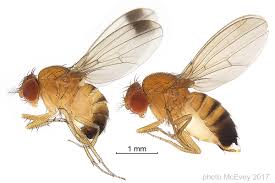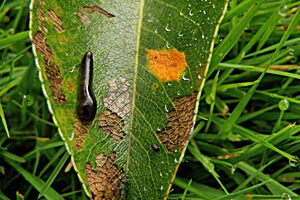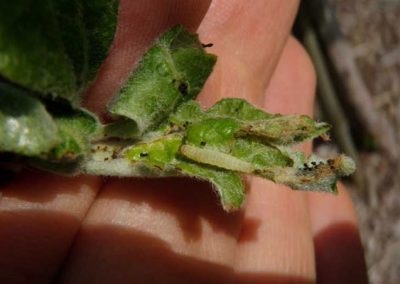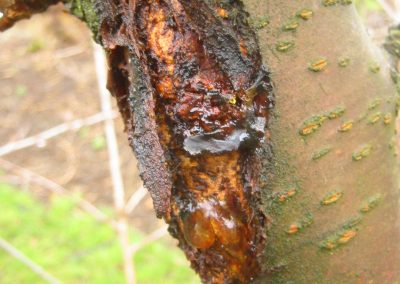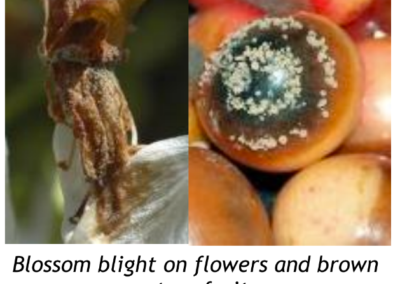Growing cherries
If you are just getting started, check out our fruit trees 101 page for beginner tips and terminology.
Pollination and Rootstocks
Many sweet cherries are self-fertile, but a few do need pollinizers. If your chosen variety needs a pollinizer, almost any other sweet cherry will work, with the exception of Black Gold, which blooms later than most sweet cherry varieties. Tart cherries are self-fertile, but bloom later than most sweet cherry varieties so don’t work well as pollinizers.

Available Rootstocks
KRYMSK 6 Sweet cherries grown on Krymsk 6 will be slightly larger than Gisela 5 with slightly better anchorage and a good tolerance of a wide range of soil types. Free standing trees can be managed at 10′-12′. Spreading habit makes training easy and it can be used for UFO Cherry Systems. Tart cherries are incompatible with Krymsk 6.
MAZZARD A semi-dwarf rootstock that is somewhat tolerant of heavy or wet soils. Vigorous sweet cherries on Mazzard will become large trees if not pruned. Well anchored, so only initial staking needed. Properly maintained trees can be kept to 15′-18′. Limited varieties available.
Pruning and Training
Establishing New Trees
If the tree is unbranched, at bud break, head it back to 20″-30″ above the ground (top image). Spread branches (ideally, 3-4) as they develop to form wide angles. Allow these primary branches to grow 20″-24″ in length, then head them back all at the same level to about 6-10″ (center image). If the tree already has good branches at bud break, head the branches back so their tips are all the same level, 6-10”. Secondary branches will begin to grow from the primary branches
The next spring, when secondary branches are 20″-24″ long, head them back at the same level to 10″. New branches will begin to grow from the secondary. On more vigorous varieties, the same process for the secondary branches can be repeated for tertiary branches the same season. You may need to thin some branches out for good light penetration. Thin by removing vigorous, upright branches, leaving weaker, more horizontal branches to encourage fruiting.
As the Tree Matures
The secondary and tertiary branches become the key structural branches in the tree. The fruit develops on fruiting wood growing from these branches. Stub back about a quarter of the fruiting wood each year after the fruit is harvested to renew it for following years. In the autumn, top the trees at 8′. Each spring, prune to thin vigorous upright branches, remove any diseased or damaged wood, and maintain the overall structure.
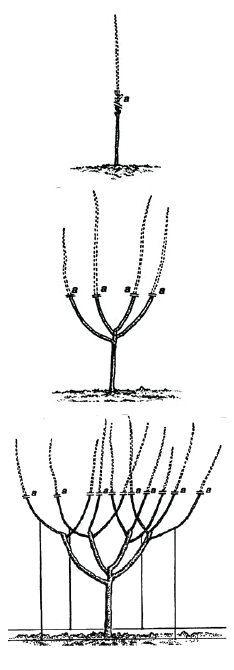
Upright Fruiting Offshoot (UFO) Training for Sweet Cherries
The Upright Fruiting Offshoots (UFO) system for sweet cherries was developed to utilize the sweet cherry’s natural upright growth habit and manage vigor by establishing multiple vertical structural fruiting units. This simplifies maintenance and achieves uniform light distribution. At maturity, the UFO system yields a fruiting wall comprised of a permanent single horizontal trunk from which renewable fruiting shoots are grown vertically up a trellis. UFO training may be used to establish a pedestrian orchard where very short or no ladders are needed, though higher yields in the single vertical wall UFO can be achieved by maintaining a tree height of 12′-15′.
At Planting
- Unpruned and unbranched (whip) trees on the Geisla 5 roostock are recommended. Trellis should be at least 5 wires, lowest wire at 20″, then spaced every 18″-20″. Space rows 9′-10′ apart. In the row, space trees 5′-6′ apart.
- Plant trees at a 45-degree angle pointing the terminal to the south. This reduces the potential for sunburn on the trunk during establishment. Important: do not plant the trees vertically and bend them to a 45-degree angle. Tie the trunk where it intersects the lowest wire to maintain the planting angle.
- Remove any other tree branches with thinning cuts. Manually rub off all buds below the first trellis wire. Score the bark with a coarse saw blade above upper buds about every 8″ to stimulate vertical shoot formation.
First Growing Season
- Remove any shoots that form below the first trellis wire. In late spring, evaluate growth uniformity of vertical shoots; head any excessively strong shoots to a stub of no more than 2 inches. New shoots that regrow from the stub should be more uniform.
- Once new shoots at the tip are 12 inches or longer, train trees to the lowest wire by removing the initial clip and placing it further along the trunk so that the orientation is slightly above horizontal.
First Dormant Season
- Thin out weakest or most vigorous shoots if density exceeds one per approximately 8-10 inches per plain. Keep all shoots growing at same height as much as possible.
- Where possible, clip or tie shoots to the second wire. Remove any shoots growing downward from the main leader.
Second Growing Season
- Where big gaps on the horizontal trunk exist, score above upper facing buds to promote completion of vertical shoot formation. Tie or clip upright shoots to trellis wires as growth allows. Remove any new shoots from below the first trellis wire.
- In late spring, evaluate growth uniformity of new vertical shoots; head any excessively strong shoots to a stub of no more than 2″ to promote regrowth.
- In mid-summer, remove excessively vigorous uprights and thin if density exceeds one per approximately 8 inches. For highly productive varieties, remove all lateral shoots on upright leaders with thinning cuts; on moderately productive varieties, remove all lateral shoots on upright leaders with stub cuts (i.e., leaving three to seven buds for additional fruiting). Tie or clip upright shoots to wires.

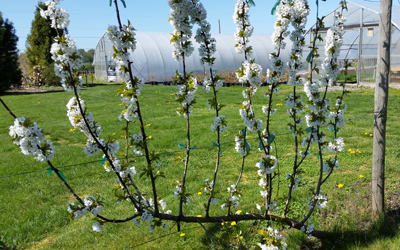
pests and diseases
Spotted Wing Drosophilia (SWD)
This fruit fly lays their eggs on ripening soft fruit, hatch, eat inside the fruit until the fruit drops, and then exit to pupate in the ground. If you are finding small white maggots in your cherries at harvest, this is the most likely culprit. You can confirm by setting out vinegar traps to monitor for the flies. Pick and dispose of any infected fruit on the tree or ground. If flies are present in large numbers, you can use Spinosad sprays.
Cherry/Pear Slug
This pest is the larvae of a sawfly that chews the upper leaf surface. There can be 2 generations of this pest. The most serious generation is the first generation, which can appear in June. The larvae can cause enough leaf damage to decrease photosynthesis in the tree. Pick off the larvae. The leaves can also be dusted with diatomaceous earth, and Spinosad sprays can also be effective.
Leaf Roller
Leaf roller larvae feed on leaves and then pupate in a rolled leaf. A spray just as the buds break dormancy (also called the delayed dormant period) containing horticultural oil can smother overwintering eggs. Bacillus thuringiensis (Bt) sprayed during the growing season can also help control damage.
Bacterial Canker
The most common disease in cherries, bacterial canker occurs when Pseudomonas syringae pv. Syringae bacterium infect plant tissues and multiply. The result is cankers that form in winter and spring on the branches that exude gum. Cankers that surround or “girdle” a branch can cause the branch to dieback. To prevent bacterial canker, plant resistant varieties and make sure to continue proper pruning, watering, and fertilizing: a healthy tree is less susceptible to infection. If you see cankers, remove branches back below the canker and dispose. Copper sprays used to be recommended but has since been proven ineffective.
Blossom Blight/Brown Rot
This fungal disease can cause blossoms to drop, buds to die, and the fruit to rot before ripening. Infected flowers will turn light brown and may have patches of buff-colored spores; infected twigs and branches may also have patches of spores. Infected fruit will begin to have dark spots that rapidly enlarge and include the same spores. Infected twigs, branches, and fruit on the tree or ground should be removed and disposed of. A sulfur spray during bloom can help prevent infection on blossoms. After bloom, sulfur can be used if needed to prevent fruit damage.
Year in Review
Winter
Spring
- Prune to thin vigorous upright branches, remove any diseased or damaged wood, and maintain structure. Be sure there is a 48-hour window of dry weather after pruning.
- Spray sulfur during for blossom blight. Add Bt for leaf roller if needed.
Summer
- Use bird netting to protect ripening fruit.
- Water, weed, and monitor for other pests and disease.
- Harvest! Stub back fruiting wood after harvest.
Fall


